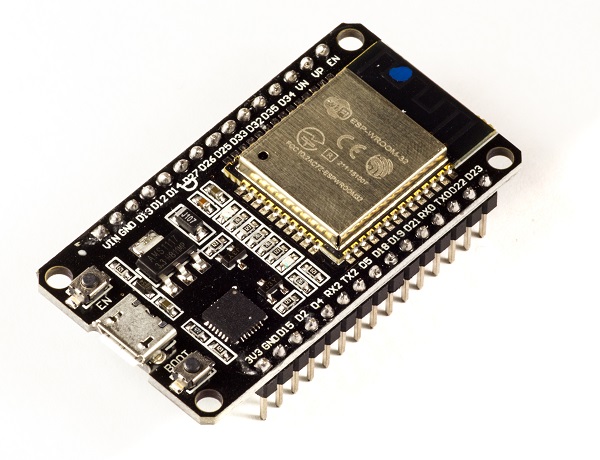In today’s world of smart devices, automation, and wireless connectivity, the ESP32 stands out as one of the most powerful and affordable microcontrollers available. Designed by Espressif Systems, the ESP32 is a Wi-Fi + Bluetooth-enabled development board used for creating IoT (Internet of Things), robotics, and embedded systems projects.
Whether you’re a student, hobbyist, or a developer building next-generation smart devices, this guide will help you understand what the ESP32 is, how it works, and how you can use it in your projects.
See The Video Tutorial
What is ESP32?
The ESP32 is a low-cost, low-power microcontroller with integrated Wi-Fi and Bluetooth (both Classic and BLE). It’s the successor of the popular ESP8266, and it comes with more GPIOs, faster processing power, dual-core CPUs, and multiple peripherals.
It can be used for:
-
Home automation
-
Industrial IoT
-
Robotics
-
Smart agriculture
-
Wearable devices
-
Wireless sensor networks
ESP32 Specifications

| Feature | Description |
|---|---|
| CPU | Dual-core Tensilica Xtensa LX6 (240 MHz) |
| RAM | ~520 KB SRAM |
| Flash Memory | 4 MB (varies by board) |
| Wi-Fi | 802.11 b/g/n |
| Bluetooth | Classic and BLE (Bluetooth Low Energy) |
| GPIO Pins | ~34 (varies by board) |
| ADC | 18 channels (12-bit) |
| DAC | 2 channels |
| PWM | Yes |
| SPI / I2C / UART | Multiple interfaces supported |
| Operating Voltage | 3.3V |
Componants need.
Types of ESP32 Development Boards
There are many versions of the ESP32. The most commonly used ones are:
-
ESP32 DevKit v1 – Most popular for beginners
-
ESP32 WROOM-32 – Compact and widely used module
-
ESP32 WROVER – With extra PSRAM (useful for camera/AI projects)
-
TTGO T-Display ESP32 – Comes with a built-in color screen
-
ESP-EYE – For facial recognition and AI applications
How to Program ESP32
You can program ESP32 using:
1. Arduino IDE
-
Install the ESP32 board package from the Board Manager.
-
Write sketches similar to Arduino Uno.
-
Simple, beginner-friendly.
2. PlatformIO (VS Code)
-
Professional development environment.
-
Better project organization and debugging.
3. MicroPython
-
Write Python code directly.
-
Great for rapid development and learning.
4. Espressif IDF (IoT Development Framework)
-
Native framework for advanced developers.
Cool Project Ideas with ESP32
-
Smart door lock (Wi-Fi controlled)
-
Wireless weather station
-
Voice-controlled home automation
-
ESP32-based robot with mobile app control
-
ESP32 + camera for facial detection
-
Bluetooth-based fitness tracker
How to Upload Code to ESP32 (Arduino IDE Example)
✅ Steps:
-
Install Arduino IDE
-
Go to
Preferencesand add this URL:https://raw.githubusercontent.com/espressif/arduino-esp32/gh-pages/package_esp32_index.json -
Go to Boards Manager > Search ESP32 > Click Install
-
Select board: “ESP32 Dev Module”
-
Connect ESP32 via USB
-
Write your code and hit Upload
Cool Project Ideas with ESP32
-
Smart door lock (Wi-Fi controlled)
-
Wireless weather station
-
Voice-controlled home automation
-
ESP32-based robot with mobile app control
-
ESP32 + camera for facial detection
-
Bluetooth-based fitness tracker
ESP32 vs ESP8266 (NodeMCU) – Quick Comparison
| Feature | ESP32 | ESP8266 (NodeMCU) |
|---|---|---|
| CPU | Dual-core | Single-core |
| Bluetooth | Yes (BLE + Classic) | No |
| GPIO | ~34 | ~17 |
| ADC Channels | 18 | 1 |
| PWM | Multiple | Limited |
| Cost | Slightly higher | Lower |
👉 Conclusion: If you’re building advanced IoT or robotics projects, go for ESP32.
Conclusion
The ESP32 is an all-in-one microcontroller perfect for IoT, robotics, and AI-powered applications. With built-in Wi-Fi and Bluetooth, a powerful dual-core processor, and lots of GPIOs, it’s a must-have for students, hobbyists, and engineers alike.
Ready to explore the smart world with ESP32? Stay tuned for our upcoming tutorials on how to build your first IoT project with ESP32

